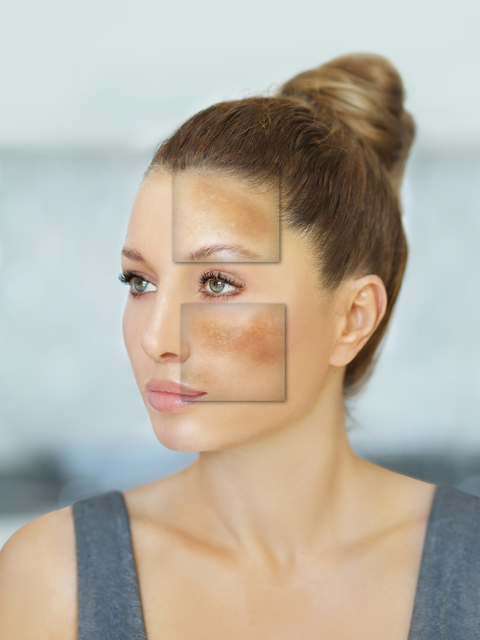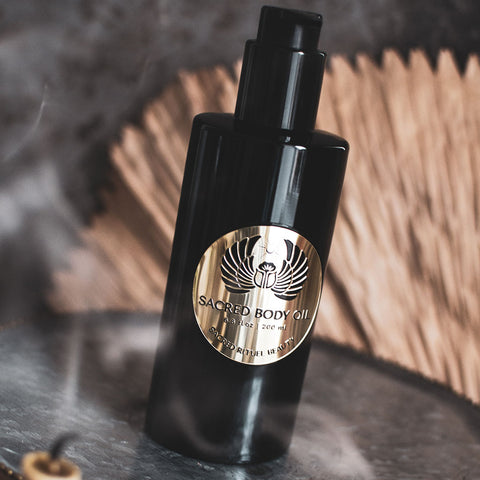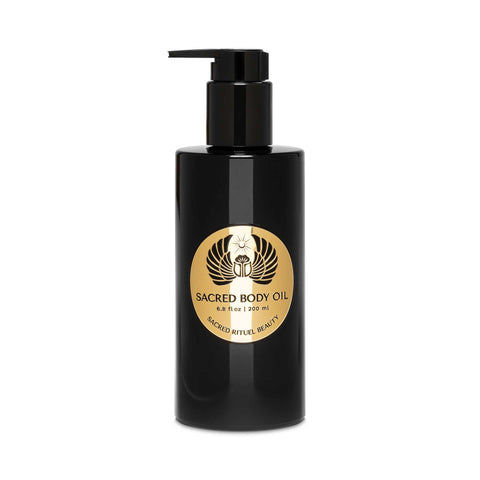
Melasma vs Hyperpigmentation: Key Differences And Best Solutions
Key Takeaways:
- Understanding Differences: Melasma is hormonally driven, while hyperpigmentation has varied causes like sun damage and skin injury.
- Treatment Options: Effective treatments range from topical agents to laser therapies, tailored to each condition.
- Prevention Tips: Consistent sun protection and gentle skincare routines are crucial for managing both conditions.
At Sacred Rituel, we pride ourselves on offering high-potency, all-organic skincare solutions that harness the power of Earth's most sacred healing plants. Our products are meticulously crafted to nourish, protect, and rejuvenate your skin, ensuring you achieve a natural, radiant glow. Understanding skin conditions like melasma and hyperpigmentation is crucial for maintaining healthy, even-toned skin. These conditions, while often confused, have distinct differences that require specific treatments.
In this piece, we will discuss the key differences between melasma and hyperpigmentation and explore the best solutions for managing each.
Understanding Melasma: Causes And Characteristics
Melasma is a common and often stubborn skin condition that manifests as brown or grayish-brown patches on the face. It is particularly noticeable on the cheeks, forehead, nose, and upper lip. Known as the "mask of pregnancy" due to its prevalence among pregnant women, melasma can affect anyone regardless of gender. This condition, while benign, can cause significant cosmetic concerns and affect the quality of life for those who experience it. To effectively manage melasma, it is crucial to understand its underlying causes and characteristics.
The Role Of Hormonal Changes In Melasma Development
One of the most significant contributors to melasma is hormonal fluctuation. Hormonal changes, such as those that occur during pregnancy, with the use of birth control pills, or through hormone replacement therapy, can trigger melasma. The hormones estrogen and progesterone are believed to stimulate the overproduction of melanin, the pigment responsible for skin color, leading to the formation of dark patches. This explains why melasma is more common in women, particularly during periods of hormonal upheaval.
The Impact Of Sun Exposure On Melasma
Sun exposure is another critical factor in the development and exacerbation of melasma. Ultraviolet (UV) light from the sun can stimulate melanocytes, the cells in the skin that produce melanin. In individuals prone to melasma, UV exposure causes these melanocytes to produce excessive amounts of melanin, resulting in the characteristic dark patches. Even brief periods of sun exposure can worsen the condition, making sun protection a vital component of melasma management.
Genetic Predisposition To Melasma
Genetics also play a crucial role in the development of melasma. Individuals with a family history of melasma are more likely to develop the condition themselves. This genetic predisposition suggests that certain individuals have a higher baseline activity of melanocytes, making them more susceptible to the triggers that cause melasma. Understanding this genetic link is essential for recognizing who might be at higher risk for developing melasma, allowing for earlier intervention and management.
The Influence Of Skin Type On Melasma Risk
Skin type is another factor that influences the likelihood of developing melasma. Those with darker skin tones are more prone to the condition due to their naturally higher levels of melanin production. This increased baseline melanin can make the skin more reactive to triggers such as hormonal changes and sun exposure, leading to the development of melasma. Consequently, individuals with darker skin should be particularly vigilant about sun protection and monitoring their skin for early signs of melasma.
Identifying The Characteristics Of Melasma
Melasma is easily recognizable due to its distinct appearance. It typically presents as symmetrical, blotchy patches that are darker than the surrounding skin. These patches most commonly appear on sun-exposed areas of the face, such as the cheeks, forehead, and upper lip, but they can also occur on the neck, forearms, and other parts of the body. The symmetry of the patches is a hallmark of melasma, distinguishing it from other skin conditions.
The Chronic Nature Of Melasma
Melasma is a chronic condition that can persist for years or even decades if not properly managed. The dark patches may fade in the winter months when sun exposure is reduced, but they often return with even minimal sun exposure. Because of its chronic nature, managing melasma typically requires long-term strategies that include sun protection, topical treatments, and sometimes medical procedures. While melasma can be challenging to treat, understanding its persistent nature is key to developing an effective and sustainable treatment plan.
Discover the perfect skincare essentials to enhance your routine! Explore our most popular picks at Sacred Rituel and find the products that best suit your needs. Whether you're looking to nourish your skin, address specific concerns, or simply treat yourself to something luxurious, our curated collection has something for everyone. Don't wait—elevate your skincare game today!
What Is Hyperpigmentation? Types And Triggers
Hyperpigmentation is a skin condition marked by darkened areas due to an overproduction of melanin, the pigment that gives skin its color. Unlike melasma, which is often linked to hormonal changes, hyperpigmentation can be triggered by various factors and can appear on any part of the body. Understanding its different types and triggers is essential for effective treatment.
Post-Inflammatory Hyperpigmentation (PIH)
Post-inflammatory hyperpigmentation (PIH) occurs after the skin experiences inflammation or injury, such as acne, eczema, or cuts. As the skin heals, it may produce excess melanin, resulting in dark spots on the affected area. PIH is more common in darker skin tones but can affect anyone. It may fade over time but can persist for months or longer without proper treatment.
Sunspots (Solar Lentigines)
Sunspots, or solar lentigines, are flat, brown spots that develop on sun-exposed areas like the face, hands, and arms due to prolonged UV exposure. Unlike PIH, sunspots are not related to injury but are a result of cumulative sun damage over time. They are a common sign of aging, though they can appear at any age.
Freckles (Ephelides)
Freckles are small, flat spots that become more noticeable with sun exposure. Common in lighter skin tones, they often have a genetic component. Freckles are more pronounced during the summer when UV exposure is higher, signaling an increase in melanin production in response to the sun.
Age Spots
Age spots, also known as liver spots, are a form of hyperpigmentation that appears with aging, primarily due to accumulated sun exposure. These larger, darker spots commonly appear on areas most exposed to the sun, such as the face, hands, and arms. While harmless, they can be a cosmetic concern for many.
Sun Exposure: The Primary Trigger
Sun exposure is the leading cause of hyperpigmentation. UV rays stimulate melanin production as the skin's defense mechanism, but overproduction can result in dark patches. Sun protection, especially using sunscreen, is vital for both preventing and managing hyperpigmentation.
Skin Injury And PIH
Skin injuries, like cuts or acne, can lead to post-inflammatory hyperpigmentation. As the skin heals, it may produce excess melanin, causing dark spots that can linger long after the injury has healed. Proper skincare can help reduce the risk and duration of PIH.
Hormonal Changes
Hormonal fluctuations, such as those during pregnancy or from birth control pills, can also trigger hyperpigmentation, though this is more commonly associated with melasma. Individuals prone to hyperpigmentation should be aware of this connection as it may require a tailored treatment approach.
Medication-Induced Hyperpigmentation
Certain medications, including antibiotics and chemotherapy drugs, can cause hyperpigmentation as a side effect. The appearance and severity of medication-induced hyperpigmentation vary depending on the drug and the individual's skin type. Consulting a healthcare provider is important if medication is suspected as the cause.

Key Differences Between Melasma And Hyperpigmentation
Melasma and hyperpigmentation both lead to darkened skin, but they differ in causes, appearance, and the populations they affect. Recognizing these distinctions is key to proper diagnosis and treatment. Although both involve excess melanin, their triggers and presentations are unique, requiring different management approaches.
Causes: Hormones vs. Various Triggers
Melasma is primarily driven by hormonal changes, often worsened by sun exposure. It's closely linked to pregnancy, birth control pills, and hormone replacement therapy, where hormonal fluctuations trigger excess melanin production. Sun exposure can further darken the patches, making sun protection crucial.
Hyperpigmentation, however, stems from a wider range of causes, including sun exposure, skin injuries, inflammation, and certain medications. Unlike melasma, it's not directly tied to hormonal changes. Instead, it results from the skin's response to various factors, leading to dark spots or patches.
Appearance: Symmetrical Patches vs. Diverse Forms
Melasma appears as large, symmetrical patches of brown or grayish-brown skin, mainly on the face—especially the cheeks, forehead, and upper lip. Its symmetrical pattern makes it distinct.
Hyperpigmentation can vary in form, from small spots like sunspots or freckles to larger, uneven patches like post-inflammatory hyperpigmentation. It can occur anywhere on the body, depending on the cause, making it more complex to diagnose and treat.
Affected Population: Women vs. Anyone
Melasma mostly affects women, particularly those with darker skin tones, often during pregnancy or due to hormonal treatments. While it can occasionally affect men, it is primarily a condition seen in women of childbearing age.
Hyperpigmentation can affect anyone, regardless of gender or skin type. Some forms, like sunspots, are more common in older individuals due to accumulated sun exposure, but the condition is not restricted to any specific demographic.
Treatment And Management: Targeted Strategies
Treating melasma typically involves a combination of topical depigmenting agents, strict sun protection, and sometimes laser therapy. Addressing hormonal imbalances may also be necessary.
Hyperpigmentation treatment varies based on its cause. Options include topical treatments, chemical peels, laser therapy, and sun protection. Because of its diverse triggers, treatment must be personalized to the specific type of hyperpigmentation.
Prevention Tips For Both Melasma And Hyperpigmentation
Preventing melasma and hyperpigmentation is easier than treating these conditions once they have developed. By following some key preventive measures, you can minimize the risk of these skin issues and keep them under control.
- Daily Sunscreen Use: Apply a broad-spectrum sunscreen with at least SPF 30 every day, regardless of the weather. Reapply every two hours when outdoors and after swimming or sweating to maintain protection.
- Seek Shade: Avoid direct sun exposure, especially during peak hours (10 a.m. to 4 p.m.). Whenever possible, stay in shaded areas or use umbrellas to reduce the risk of UV-induced pigmentation.
- Protective Clothing: Wear wide-brimmed hats, sunglasses, and long-sleeved clothing to shield your skin from harmful UV rays. These physical barriers provide additional protection, especially during outdoor activities.
- Hormonal Management: If you are prone to melasma, be mindful of hormonal changes that could trigger the condition. Discuss alternative treatments with your healthcare provider if birth control pills or hormone therapy are a concern.
- Skin Trauma: Avoid picking at acne, wounds, or other skin irritations to prevent post-inflammatory hyperpigmentation. Be gentle with your skin, particularly when using exfoliants or active skincare products.
- Gentle Cleansing: Use a gentle cleanser to avoid irritating the skin, which can lead to hyperpigmentation. Choose products free of harsh chemicals and fragrances to maintain a healthy skin barrier.
- Regular Exfoliation: Exfoliate regularly to remove dead skin cells and prevent melanin buildup, but avoid over-exfoliating, which can cause irritation and worsen pigmentation. Finding a balance is key to maintaining clear, even-toned skin.
- Moisturization: Keep your skin well-moisturized to strengthen the skin barrier and protect against environmental factors that contribute to pigmentation issues. Regular moisturization also helps maintain overall skin health.
- Early Intervention: If you notice any new dark spots or changes in your skin, consult a dermatologist promptly. Early treatment can prevent these spots from becoming more pronounced and difficult to treat.
- Routine Skin Checks: Regularly monitor your skin for any changes, particularly if you have a history of hyperpigmentation or melasma. Early detection allows for timely intervention and better management of these conditions.
- Antioxidant-Rich Diet: Consume a diet rich in antioxidants, such as Vitamin C and E, to help protect your skin from oxidative stress. A healthy diet supports your skin’s natural defenses against pigmentation issues.
- Stay Hydrated: Drink plenty of water to keep your skin hydrated, which helps maintain its natural barrier and repair mechanisms. Well-hydrated skin is more resilient against external factors that can lead to pigmentation.
- Limit Exposure to Heat: Avoid environments with excessive heat, such as saunas and hot yoga, which can exacerbate melasma. Keeping cool helps prevent heat-related pigmentation issues.
- Cool Down: After sun exposure or physical activity, cool your skin with a cold compress or by washing with cool water. This reduces the risk of triggering pigmentation and soothes the skin.
By integrating these preventive measures into your daily routine, you can effectively reduce the risk of developing melasma and hyperpigmentation or keep existing conditions under control.
When To Seek Professional Help For Melasma And Hyperpigmentation
While many cases of melasma and hyperpigmentation can be effectively managed with over-the-counter treatments and lifestyle adjustments, there are times when professional intervention is necessary. Consulting a dermatologist or skincare professional can ensure that you receive the most effective treatment, prevent potential complications, and achieve the best possible outcomes for your skin. Here are the key situations in which seeking professional help is recommended.
Persistent Or Worsening Pigmentation
If you’ve been diligently treating melasma or hyperpigmentation at home but have not seen any improvement, or if the condition seems to be worsening, it’s crucial to seek professional advice. Over-the-counter products can be helpful, but they may not be strong enough for more stubborn cases. A dermatologist can assess your skin and provide stronger, prescription-grade treatments that are more likely to be effective. Additionally, they can offer tailored advice on how to adjust your skincare routine to better address your specific needs, ensuring that your efforts are not in vain.
Severe Or Extensive Pigmentation
When pigmentation covers a large area of the skin or is particularly dark and noticeable, standard over-the-counter treatments might not be enough. In such cases, the expertise of a dermatologist becomes invaluable. They can evaluate the severity of your condition and recommend advanced treatments like laser therapy, prescription creams, or chemical peels that can provide more significant results. These treatments often require professional supervision to ensure they are administered safely and effectively, minimizing the risk of adverse effects.
Uncertain Diagnosis
If you are unsure whether you are dealing with melasma, hyperpigmentation, or another skin condition, it is essential to obtain a proper diagnosis. Different skin conditions can present with similar symptoms, and misdiagnosing yourself can lead to ineffective or even harmful treatment choices. A dermatologist can accurately differentiate between these conditions, using their expertise and possibly additional diagnostic tools, to ensure that you receive the correct treatment. This is particularly important because some pigmentation issues require specific types of treatments that are not suitable for other conditions.
Side Effects From Treatment
Experiencing irritation, redness, or other side effects from over-the-counter treatments is a clear sign that you should consult a dermatologist. While some mild side effects are common, persistent or severe reactions could indicate that a product is too harsh for your skin or that you might have an allergy to one of its ingredients. A dermatologist can recommend gentler alternatives that are less likely to cause irritation and may prescribe medications designed for sensitive skin. This approach helps you avoid further aggravating your skin while still addressing the pigmentation issues.
Interest In Advanced Treatments
If you are considering advanced treatments such as laser therapy, microneedling, or prescription-strength creams, it is crucial to do so under the guidance of a qualified professional. These treatments can be highly effective but also carry certain risks if not administered correctly. A dermatologist can assess whether you are a good candidate for these procedures and guide you through the process, ensuring that the treatment is performed safely and with the appropriate aftercare. This professional oversight can maximize the benefits of the treatment while minimizing potential complications.
Managing Expectations
One of the most important roles a dermatologist can play is in helping to manage your expectations regarding treatment outcomes and timelines. Pigmentation issues like melasma and hyperpigmentation often take time to improve, and it is easy to become frustrated if results are not immediate. A dermatologist can provide realistic expectations, explain the likely course of treatment, and offer support throughout the process. This guidance helps you stay committed to your treatment plan and reduces the likelihood of abandoning it prematurely due to unrealistic expectations.

Final Thoughts
Understanding the differences between melasma and hyperpigmentation is essential for effective treatment and prevention. While melasma is often tied to hormonal changes and requires targeted therapy, hyperpigmentation can result from various factors, each needing a specific approach. By identifying your specific skin concern and adopting a comprehensive treatment plan—including sun protection, topical treatments, and possibly professional therapies—you can achieve a clearer, more even skin tone. Always consult with a dermatologist to tailor the best strategy for your unique skin needs.
Read also:
- How to Choose the Best Natural Skin Tint for a Flawless Complexion
- How to Choose the Best Natural Glow Serum for Your Skin Type
- Why You Should Use an Organic Glow Serum: Benefits and Top Product
Frequently Asked Questions About Melasma And Hyperpigmentation
What is the main difference between melasma and hyperpigmentation?
Melasma is primarily triggered by hormonal changes and sun exposure, while hyperpigmentation can result from various causes, including skin injuries, sun exposure, and aging.
Can men develop melasma, or is it only a women's condition?
While melasma is more common in women, men can also develop it, especially if they have a genetic predisposition or significant sun exposure.
Is hyperpigmentation always permanent?
Hyperpigmentation is not always permanent. It can fade over time with proper treatment, though some forms, like sunspots, may be more resistant to fading.
How long does it take for melasma to fade with treatment?
Melasma can take several months to show improvement with treatment, and ongoing maintenance may be necessary to prevent recurrence.
Are natural remedies effective for treating hyperpigmentation?
Some natural remedies, like aloe vera or green tea extract, can help lighten hyperpigmentation, but they may not be as effective as clinical treatments.
Can laser treatments make melasma worse?
Yes, some laser treatments can exacerbate melasma if not done correctly. It's essential to consult with a dermatologist experienced in treating melasma before opting for laser therapy.
What are the risks of not treating hyperpigmentation?
If left untreated, hyperpigmentation can become more pronounced, especially with continued sun exposure. In some cases, it may become permanent.
Can melasma occur in areas other than the face?
Yes, melasma can appear on other sun-exposed areas, such as the neck and forearms, although it most commonly affects the face.
Does diet play a role in preventing hyperpigmentation?
A diet rich in antioxidants may help protect the skin from oxidative stress, which can contribute to hyperpigmentation, though it is not a standalone solution.
Can stress cause melasma or hyperpigmentation?
Stress alone is not a direct cause, but it can exacerbate conditions like melasma due to its impact on hormone levels and overall skin health.
Sources:
- McKesey, J., Tovar-Garza, A., & Pandya, A. G. (2019). Melasma Treatment: An Evidence-Based Review. American Journal of Clinical Dermatology, 21(2). https://doi.org/10.1007/s40257-019-00488-w
- Neagu, N., Conforti, C., Agozzino, M., Marangi, G. F., Morariu, S. H., Pellacani, G., Persichetti, P., Piccolo, D., Segreto, F., Zalaudek, I., & Dianzani, C. (2022). Melasma treatment: a systematic review. Journal of Dermatological Treatment, 33(4), 1816–1837. https://doi.org/10.1080/09546634.2021.1914313
- Nautiyal, A., & Wairkar, S. (2021). Management of Hyperpigmentation: Current Treatments and Emerging Therapies. Pigment Cell & Melanoma Research, 34(6). https://doi.org/10.1111/pcmr.12986







Commentaires (0)
Il n'y a pas de commentaires pour cet article. Soyez le premier à laisser un message !